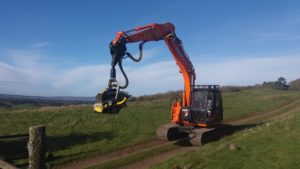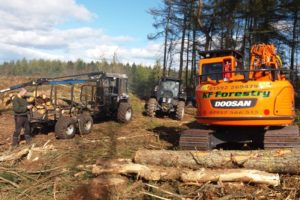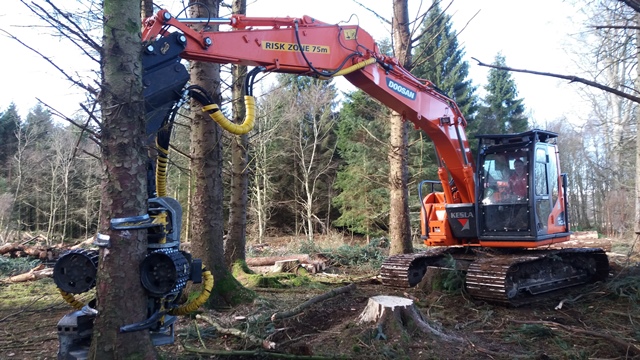Forest Plans and Woodland Plans (FWN 28)
1 March 2017Most things in life which need to be built or managed require some kind of plan. Forestry is no different. In fact, given the long-term nature of forestry, one of the most useful tools at a woodland owner’s disposal is some type of plan which sets out management proposals covering up to 20 years.
There are numerous benefits from having a forest or woodland plan:
- Identifying and quantifying what’s in the forest
- Grants for existing woodland require a plan to be in place before-hand
- Plans are required to allow timber to be sold into the biomass sector for use in RHI-funded boilers
- Financial planning
- Operational planning: identifying where economies of scale can be taken advantage of, establishing a timeline
- Ensuring compliance with the UK Forestry Standard (UKFS).
Long Term Forest Plan vs Woodland Management Plan
The terms woods and forests are used interchangeably throughout this article, but there is a difference between a Long Term Forest Plan (LTFP) and a Woodland Management Plan (WMP).
The LTFP is aimed at woods and forests of over 100ha in size, be this in one block or scattered over a single property. Grant funding is available for it. The grant contributes to the cost of all survey work, consultation, mapping and writing of the plan. It usually takes several months to complete, from grant application through to plan approval. The grant application requires a concept map to be submitted, which gives a broad outline of management activities (without detail) and highlights the constraints and opportunities affecting the woods. A great deal of emphasis is placed on consultation (known as Scoping) for the LTFP, which is normally undertaken through letters, but also formal meetings or drop-in sessions if appropriate. A Scoping Report is produced which summarises the issues raised and how these will be addressed and must be approved by the Forestry Commission before going on to complete the rest of the plan and the proposals, which is then approved by the Forestry Commission. The plan period is for 20 years, and when approved, provides felling approval for the first 10 years. A separate felling licence application is not therefore needed for the felling proposals.
The WMP is aimed at woods of less than 100ha, again whether it is in one block or scattered throughout a property. There is no grant for it, but this reflects the simplified nature of the WMP compared to the LTFP. It can be completed in days or hours. Consultation can be undertaken less formally, and all information is recorded in the WMP template (no separate scoping report). The completed plan is submitted to the Forestry Commission for approval, but this does not give you felling permission. A separate felling licence application must be submitted; either at the same time as the plan or straight after plan approval is a sensible time to do so. Felling licence applications will be required for subsequent proposals later in the plan period.
Both plans, when approved, are given a unique reference number. This number must be quoted in grant applications for existing woodlands. For supply into the biomass sector, the reference number of the LTFP must be given or, the WMP reference number along with the felling licence reference number.
Both plans, and their proposals, must comply with the UK Forestry Standard (UKFS), which is the industry-accepted code of practice.
What’s in the wood?
For many landowners, the woods are a familiar feature that are on the farm or estate, but about which there is very little detail. This is the starting point of every plan: identifying what is there, what it’s like, where it is, and how much there is. This detail will normally include total area, species, area by species, age (or planting year), management history (eg. previous thinning) and sometimes standing timber volume. Additional detail may include yield class (the productivity of the crop), tree height and access. Site information is also required (with more detail required in the LTFP) including topography, geology and soils, climate, hydrology, adjacent land use, windthrow risk, historic environment, biodiversity, invasive species (eg. Rhododendron, Japanese knotweed) and plant health (eg. Chalara ash dieback).
This information can be displayed in a table and on a map; if you have an agent producing a plan for you they will produce a compartment schedule containing the above information, as well as a compartment map which normally includes species. A compartment is simply a distinct area of the forest which is similar in nature, and clearly delineated by a feature such as a burn or an old dyke. Each compartment is numbered, and each block of species identified with a letter.
Constraints
The constraints affecting the site must be identified. This may include steep ground, watercourses, badgers, red squirrels or European protected Species (EPS), SSSIs, SPAs, railways, windblow, native woodland, public access, lack of management access; essentially anything that would hinder or may be harmed/damaged by the management of the wood. The constraints are identified both in the plan and on a map. Designations can be easily checked online by visiting SiteLink for natural heritage, Canmore for archaeological heritage, and Scotland’s Environment for environmental information.
Objectives
Early on in the plan process it is important to set out the vision and objectives. These will be influenced to some extent by the size, nature and location of the wood, and the constraints and designations affecting it. The vision is how you see your wood well into the future and is expressed in general terms; for example, a well-thinned forest producing quality timber, or a thriving native woodland. The objectives set out what you want to achieve by managing the woodland; for example production of good quality timber, provide alternative income, improving the biodiversity of the area.
Consultation/Scoping
It is important to identify any stakeholders who should be consulted about the plan. Stakeholders are any person or organisation who may have some sort of interest in the woodland and may include neighbours, tenants, users of the woodland, conservation bodies and statutory bodies such as NatureScot (usually in relation to red squirrels, badgers, EPS, SSSIs, SPAs), SEPA (in relation to watercourses if these will be directly affected) or local authorities (usually in relation to timber transport or public access). On consultation, these stakeholders may raise issues which you were unaware of, which should be added into the list of constraints. This process is carried out in a formal manner for LTFPs via letters, meeting or drop-in session, with the issues/responses and proposed mitigation being summarised in a scoping report; for the WMP the process is more informal and any issues recorded directly within the plan template. For LTFPs, the concept map should be updated following scoping.
Analysis
The constraints are analysed and opportunities identified to work around the constraint, mitigate effects on it or prevent future issues in relation to it. For example, the constraint may be steep banking next to a watercourse (where timber harvesting could be difficult and cause soil disturbance); the opportunity being that the steep bank is restocked with broadleaves, thereby avoiding disturbance in that potentially sensitive area in the future.
If there are badgers or EPS within parts of the wood likely to be affected by management, it is essential that you obtain a licence for disturbing these species. This should be noted in the analysis section and a licence application followed through at the appropriate time.
Proposals
The final part of the plan is to set out your proposals, having considered all the above. This may include more conventional proposals such as thinning, clear-felling and restocking, or low impact activities such as group-felling, or access construction. Whatever the proposal, it should include quantity and timing (which year it will take place). All proposals should be identified on a map.
In the WMP it is sensible to state that the proposals will be carried out in accordance with the UKFS, and that appropriate protected species surveys will be undertaken ahead of any operations.
The LTFP is submitted to the Forestry Commission for approval along with a production forecast and a tolerance table. The critical information held in the production forecast is area of thinning/felling, species and year. Further information on timber volumes and yield class can be provided if readily available. The tolerance table recognises that a degree of flexibility is required in the plan to allow for unpredictable events such as storm damage or sudden changes in market conditions, but sets out the limits of the flexibility and what must be done if these limits are to be exceeded.
The WMP is submitted by itself and, a felling licence (if required) should also be submitted.
Online guidance and templates for LTFPs and WMPs can be found at Scottish Forestry – Forest Plan Resources
Malcolm Young, SAC Consulting
This article is taken from the Farm Woodland News Spring 2017 edition.
Sign up to the FAS newsletter
Receive updates on news, events and publications from Scotland’s Farm Advisory Service



